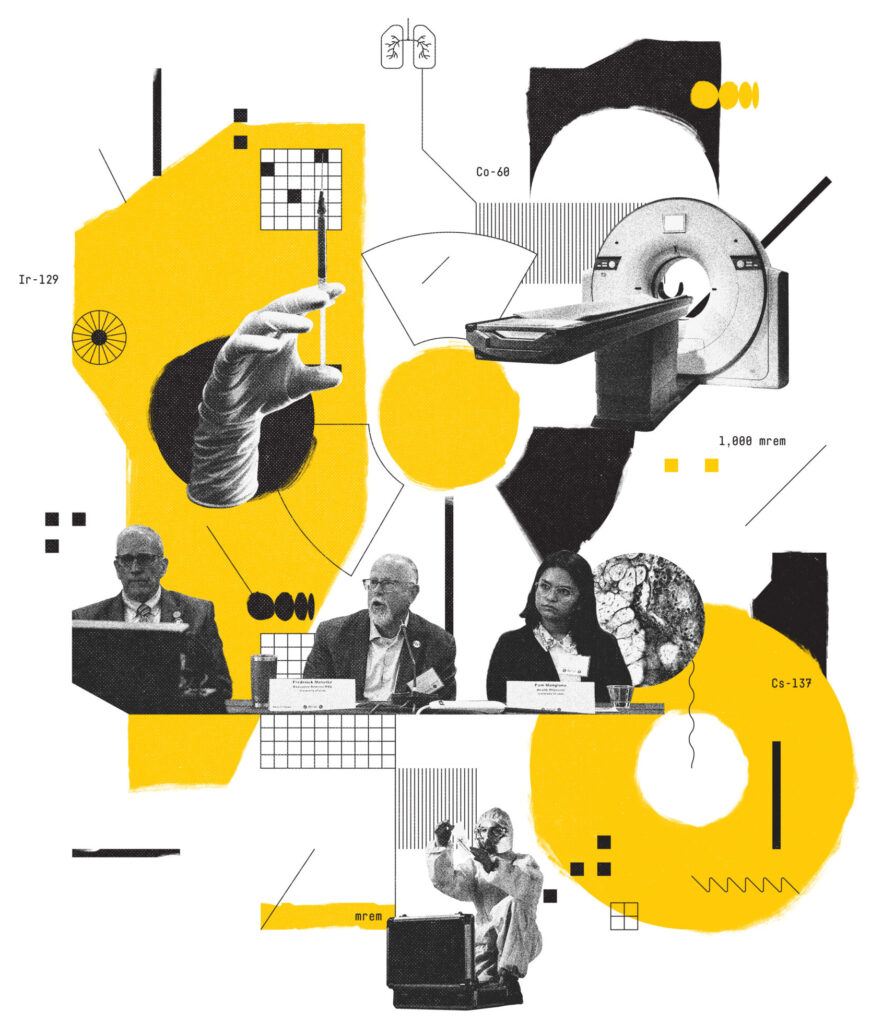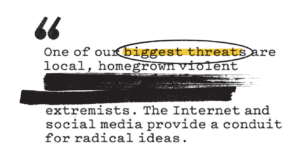 On September 6, 2023, an official from the Department of Energy (DOE) briefed a packed room. A terrorist had stolen radioactive material from University of Utah Hospital. It was cesium-137, an extremely potent salt compound used in a common medical device. Just a pinch of the stuff would make a devastating, dangerous, and dirty bomb.
On September 6, 2023, an official from the Department of Energy (DOE) briefed a packed room. A terrorist had stolen radioactive material from University of Utah Hospital. It was cesium-137, an extremely potent salt compound used in a common medical device. Just a pinch of the stuff would make a devastating, dangerous, and dirty bomb.
Now what?
This was one in a series of scenarios posed during Wasatch Thunder, an all-day event where nearly 200 people from the University of Utah and local, state, and federal agencies practiced their response should someone actually steal a radioactive source from the U. Co-hosted by the U, the FBI, and the DOE, Wasatch Thunder is part of the national Silent Thunder program, created some years ago and supported by the federal Office of Radiological Security (ORS) and the FBI to upgrade security for radioactive substances in the country. The program’s mission is to enhance global security by preventing radioactive materials from being used in acts of terrorism. They provide support, funding, and free training to any institutions with sources in the U.S.
“As a leading health care system and research university, we need to have access to equipment that facilitates cutting-edge medical treatment and scientific inquiry. That means dealing with radioactive material,” says Frederick Monette, executive director of Environmental Health and Safety and radiation safety officer of the U. “It’s crucial that we provide training, support, and emergency responses to use that technology safely. Luckily, we don’t have to do it alone.”
Though highly unlikely, an attempted theft would trigger a massive, coordinated response at all levels, from the U campus to federal agencies. Wasatch Thunder brought all stakeholders to Research Park to build connections and strengthen protocols ahead of a threat. If the crew assembled was any indication, the emergency response to such a threat would be a complex one with multiple moving parts. In the room were representatives from two dozen university and government agencies—from the U Emergency Management Division to the Salt Lake County Department of Public Health to the Utah Transit Authority. A hundred-plus other attendees were on hand to evaluate protocols and find areas for improvement.
Low Probability, High Consequence
Radioactive substances are everywhere. The names may sound scary—cesium-137, iridium-129, cobalt-60—but these materials can be forces for good, with applications that include cancer therapies, medical diagnoses, structural testing, wastewater treatment, and food sanitation. If weaponized, though, radiation can cause potentially catastrophic damage. The ORS uses three strategies to keep dangerous substances out of the wrong hands.
“Our mission is to protect, remove, and reduce,” says the agency’s Michael Fink. “Protect radioactive sources used for vital medical, research, and commercial purposes; remove or dispose of disused radioactive sources; and reduce global reliance on radioactive sources by replacing them with alternative technology.”
 Unlike firearms or chemicals, stealing a radioactive substance can be a death sentence. Sources are encased in lead, concrete, or water shielding—materials too heavy to carry easily. The danger and effort, paired with fortress-like security, make the likelihood of theft low, but not zero. In the past, law enforcement kept its eye mostly on foreign adversaries, but that’s shifted in recent years.
Unlike firearms or chemicals, stealing a radioactive substance can be a death sentence. Sources are encased in lead, concrete, or water shielding—materials too heavy to carry easily. The danger and effort, paired with fortress-like security, make the likelihood of theft low, but not zero. In the past, law enforcement kept its eye mostly on foreign adversaries, but that’s shifted in recent years.
“One of our biggest threats are local, homegrown violent extremists,” Michelle Cammack, assistant weapons of mass destruction coordinator at the FBI, told the group. “The Internet and social media provide a conduit for radical ideas. These people don’t travel out of the country to join a group. They do it here.”
Cammack shared several case studies that show a rise in domestic terrorist plots over the last few years, though none involved radioactive material. Thefts have occurred, however, and Cammack mentioned an incident from 1998, when someone stole 19 steel tubes of cesium-137 from Moses Cone Hospital in North Carolina. Authorities suspected a hospital employee but lacked enough evidence to charge. The material was never recovered.
Decoding Common Radiation Exposure
We encounter low levels of radiation in our everyday lives—from the environment, the foods we eat, and even from the cosmos. Many experience additional doses from medical procedures and diagnostics. But what exactly does this mean for us, and why should we care about different types of radiation?
Think of radiation as an invisible traveler, zipping through space and materials, carrying energy on its journey. It comes in two main guises: electromagnetic and particle radiation. Electromagnetic radiation includes the warmth of the sun on your skin, the signals received by your radio, and the light that enables you to see this page. It’s also the X-rays that peek inside your body at the dentist’s office and the gamma rays that sterilize medical equipment (and that superheroes might blame for their powers). On the flip side, particle radiation is more like tiny bullets, made up of charged fragments of atoms that shoot through space at incredible speeds.
Ionizing radiation is like the heavyweight champion of radiation types—it packs enough punch to knock electrons off their home base in atoms. Why does this matter? When atoms in your cells lose electrons, they can turn rogue and potentially harm DNA. If our cellular blueprints get damaged and the cell doesn’t fix errors correctly, it can cause them to divide uncontrollably. This is how some cancers get started, so it’s clear why ionizing radiation is something to be respected and why safety standards in hospitals and nuclear facilities are so strict.

Risk vs. Reward
Why would the U risk housing such potentially dangerous substances? They’re powerful tools for detecting and treating certain diseases, especially cancer. Huntsman Cancer Institute can’t provide world-class care without it. Radiation therapy employs X-rays, gamma rays, and charged radioactive particles to kill cancer cells. Diagnostic tests like positron emission tomography (PET) scans use a radioactive substance injected into the bloodstream to highlight cancer cells so oncologists can see where tumors are located and whether treatments are working.
Scientists also harness radioactive sources for society-enhancing research. Edward Cazalas, assistant professor of nuclear engineering in the U’s Department of Civil and Environmental Engineering, studies the effects of radiation and develops tools for detecting it. How does he work with the U’s radioactive sources?
“Very carefully,” he laughs. Part of his research involves testing electronics that have been exposed to extreme radiation. That’s a crucial piece of the puzzle for missions that rely on technology to function at high altitudes or in space.
“There’s lots of radiation in space,” Cazalas says. “If you think about a mission to Mars, the problem isn’t finding volunteers to go, or building the rockets to get there. The problem is the radiation.”
Cazalas attended Wasatch Thunder to better understand threats to sources that he works with.
“It is supremely important to keep our assets safe,” he says. “Most adversaries are dumb, but the smarter ones can cause much havoc.”
A United Front
Over the course of the Wasatch Thunder event, one theme kept rising to the top: collaboration is key for mitigating any threat. We can do it, but we can’t do it alone.
“We have seen Utahns step up and be at their best during emergencies. We must also be ready to respond to intentional acts, including the potential use of a weapon of mass destruction,” said Utah Governor Spencer Cox in a recorded message to Wasatch Thunder participants. “I have no doubt that the relationships formed and strengthened today will have long-lasting benefits to both Utahns and the nation as a whole.”
Lisa Potter is a science writer for University Marketing & Communications.



Comments
Comments are moderated, so there may be a slight delay. Those that are off-topic or deemed inappropriate may not be posted. Your email address will not be published. Required fields are marked with an asterisk (*).